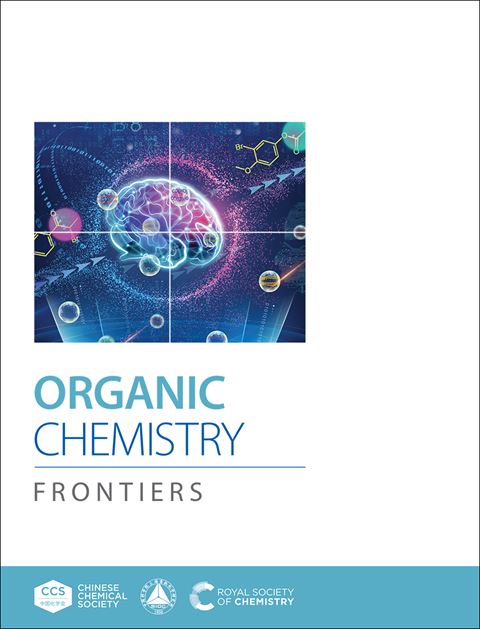Mechanistic Insights into NHC/Cu Catalyzed Asymmetric Synthesis of Spirooxindole: Origins of Enantioselectivity and Diastereoselectivity
IF 4.7
1区 化学
Q1 CHEMISTRY, ORGANIC
引用次数: 0
Abstract
Density Functional Theory (DFT) calculations were conducted to elucidate the mechanism of NHC/Cu catalyzed enantioselective annulation between isatin-derived enals and ethynyl carbonates, enabling the asymmetric synthesis of spirooxindole δ-lactones with vicinal all-carbon quaternary stereocenters. The catalytic process involves four key stages: (i) generation of azolium homoenolate intermediate IM3 via NHC-mediated nucleophilic addition to enal 1a; (ii) [Cu]-catalyzed decarboxylation of ethynyl carbonate 2a to afford the copper-alkynyl intermediate IM7; (iii) stereoselective C-C bond formation between IM3 and IM7, followed by a two-water-mediated enol-keto tautomerization yielding the ketone intermediate IM10; and (iv) NEt3-promoted deprotonation, intramolecular cyclization, and proton transfer affording product spirooxindole δ-lactone 3a. Notably, both the enantio-and diastereoselectivity-determining step and the rate-determining step occur in Stage III. Further DIAS and QTAIM analyses of four stereoisomeric transition states identify TS5(S,R) as the most favorable, exhibiting the lowest free energy barrier and multiple stabilizing non-covalent interactions (C-H⋯π, C-H⋯O, C-F⋯π, and Cu⋯H), rationalizing the observed high stereoselectivity. Water molecules are shown to play a crucial role in lowering the barrier of the rate-determining step by enhancing electrostatic, orbital, and dispersion interactions. This study not only deepens the mechanistic understanding of cooperative NHC/Cu catalysis but also provides valuable theoretical guidance for rational designing next-generation asymmetric annulation reactions.NHC/Cu催化不对称合成螺菌吲哚的机理:对映选择性和非对映选择性的起源
采用密度泛函理论(DFT)分析了NHC/Cu催化异黄酮衍生的烯醛和碳酸乙酯之间的对映选择性环化反应机理,从而实现了邻全碳季立体中心的螺嘧哚δ-内酯的不对称合成。催化过程包括四个关键阶段:(i)通过nhc介导的烯醛1a亲核加成生成azolium homoenolate中间体IM3;(ii) [Cu]催化碳酸乙酯2a脱羧得到铜-炔基中间体IM7;(iii)在IM3和IM7之间形成立体选择性C-C键,随后发生双水介导的烯醇-酮异构反应,生成酮中间体IM10;(iv) net3促进去质子化、分子内环化和质子转移,生成螺烷吲哚δ-内酯3a。值得注意的是,对映体和非对映体选择性决定步骤和速率决定步骤都发生在第三阶段。进一步的DIAS和QTAIM分析发现,TS5(S,R)是最有利的,表现出最低的自由能势垒和多种稳定的非共价相互作用(C-H⋯π, C-H⋯O, C-F⋯π和Cu⋯H),合理化了观察到的高立体选择性。水分子通过增强静电、轨道和色散相互作用,在降低速率决定步骤的势垒方面起着至关重要的作用。该研究不仅加深了对NHC/Cu协同催化机理的认识,而且为合理设计下一代不对称环化反应提供了有价值的理论指导。
本文章由计算机程序翻译,如有差异,请以英文原文为准。
求助全文
约1分钟内获得全文
求助全文
来源期刊

Organic Chemistry Frontiers
CHEMISTRY, ORGANIC-
CiteScore
7.90
自引率
11.10%
发文量
686
审稿时长
1 months
期刊介绍:
Organic Chemistry Frontiers is an esteemed journal that publishes high-quality research across the field of organic chemistry. It places a significant emphasis on studies that contribute substantially to the field by introducing new or significantly improved protocols and methodologies. The journal covers a wide array of topics which include, but are not limited to, organic synthesis, the development of synthetic methodologies, catalysis, natural products, functional organic materials, supramolecular and macromolecular chemistry, as well as physical and computational organic chemistry.
 求助内容:
求助内容: 应助结果提醒方式:
应助结果提醒方式:


